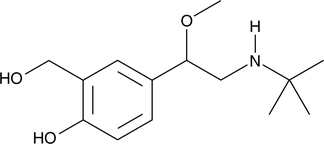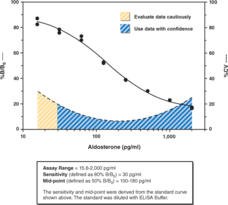Cayman
Showing 9001–9150 of 45550 results
-
Salbutamol (albuterol) is a selective β2-adrenergic partial agonist that is used as a bronchodilator.{25569} Its detection and chemical analysis is of interest in various clinical and doping abuse settings.{25237} Albuterol methyl ether is a process impurity product associated with salbutamol that may be detected in urine samples.{28822}
Brand:CaymanSKU:-Available on backorder
Salbutamol (albuterol) is a selective β2-adrenergic partial agonist that is used as a bronchodilator.{25569} Its detection and chemical analysis is of interest in various clinical and doping abuse settings.{25237} Albuterol methyl ether is a process impurity product associated with salbutamol that may be detected in urine samples.{28822}
Brand:CaymanSKU:-Available on backorder
Alcaftadine is a potent antagonist of the H1 histamine receptor (IC50 = 8.6 nM) with lower affinities for the H2 and H4 receptors (IC50s = 62 nM and 4.4 μM, respectively).{34359} This antiallergenic agent has anti-inflammatory and mast cell stabilizing effects.{34330} Alcaftadine has been shown to reduce edema and erythema in a guinea pig model of allergic conjunctivitis (ED50 = 0.1 mg/kg) more effectively than ketotifen (Item No. 20303) (ED50 = 1.0 mg/kg) and has been used in clinical formulations in eye drops for treatment of ocular itching associated with allergic conjunctivitis.{34359,34360} Alcaftadine also binds to 5-HT2A and 5-HT2C receptors (Kis = 2.5 and 1.5 μM, respectively).{34359}
Brand:CaymanSKU:21290 -Out of stock
Alcaftadine is a potent antagonist of the H1 histamine receptor (IC50 = 8.6 nM) with lower affinities for the H2 and H4 receptors (IC50s = 62 nM and 4.4 μM, respectively).{34359} This antiallergenic agent has anti-inflammatory and mast cell stabilizing effects.{34330} Alcaftadine has been shown to reduce edema and erythema in a guinea pig model of allergic conjunctivitis (ED50 = 0.1 mg/kg) more effectively than ketotifen (Item No. 20303) (ED50 = 1.0 mg/kg) and has been used in clinical formulations in eye drops for treatment of ocular itching associated with allergic conjunctivitis.{34359,34360} Alcaftadine also binds to 5-HT2A and 5-HT2C receptors (Kis = 2.5 and 1.5 μM, respectively).{34359}
Brand:CaymanSKU:21290 -Out of stock
Alcaftadine is a potent antagonist of the H1 histamine receptor (IC50 = 8.6 nM) with lower affinities for the H2 and H4 receptors (IC50s = 62 nM and 4.4 μM, respectively).{34359} This antiallergenic agent has anti-inflammatory and mast cell stabilizing effects.{34330} Alcaftadine has been shown to reduce edema and erythema in a guinea pig model of allergic conjunctivitis (ED50 = 0.1 mg/kg) more effectively than ketotifen (Item No. 20303) (ED50 = 1.0 mg/kg) and has been used in clinical formulations in eye drops for treatment of ocular itching associated with allergic conjunctivitis.{34359,34360} Alcaftadine also binds to 5-HT2A and 5-HT2C receptors (Kis = 2.5 and 1.5 μM, respectively).{34359}
Brand:CaymanSKU:21290 -Out of stock
Alcaftadine is a potent antagonist of the H1 histamine receptor (IC50 = 8.6 nM) with lower affinities for the H2 and H4 receptors (IC50s = 62 nM and 4.4 μM, respectively).{34359} This antiallergenic agent has anti-inflammatory and mast cell stabilizing effects.{34330} Alcaftadine has been shown to reduce edema and erythema in a guinea pig model of allergic conjunctivitis (ED50 = 0.1 mg/kg) more effectively than ketotifen (Item No. 20303) (ED50 = 1.0 mg/kg) and has been used in clinical formulations in eye drops for treatment of ocular itching associated with allergic conjunctivitis.{34359,34360} Alcaftadine also binds to 5-HT2A and 5-HT2C receptors (Kis = 2.5 and 1.5 μM, respectively).{34359}
Brand:CaymanSKU:21290 -Out of stock
Alclometasone dipropionate (ACM) is a corticosteroid.{41325} It reduces cutaneous anaphylaxis reactions induced by tuberculin or albumin in mice when administered topically (20 μl of a 0.1% solution). ACM also inhibits androgen-dependent cytochrome P450 activity and the O-depropylation activity of 7-alkoxy-coumarin O-dealkylase in a dose-dependent manner in male rats but has no effect on hepatic drug metabolism in female rats or mice of both sexes.{41326} Formulations containing ACM have been used to treat radiation and allergic contact dermatitis.
Brand:CaymanSKU:23901 - 10 mgAvailable on backorder
Alclometasone dipropionate (ACM) is a corticosteroid.{41325} It reduces cutaneous anaphylaxis reactions induced by tuberculin or albumin in mice when administered topically (20 μl of a 0.1% solution). ACM also inhibits androgen-dependent cytochrome P450 activity and the O-depropylation activity of 7-alkoxy-coumarin O-dealkylase in a dose-dependent manner in male rats but has no effect on hepatic drug metabolism in female rats or mice of both sexes.{41326} Formulations containing ACM have been used to treat radiation and allergic contact dermatitis.
Brand:CaymanSKU:23901 - 25 mgAvailable on backorder
Alclometasone dipropionate (ACM) is a corticosteroid.{41325} It reduces cutaneous anaphylaxis reactions induced by tuberculin or albumin in mice when administered topically (20 μl of a 0.1% solution). ACM also inhibits androgen-dependent cytochrome P450 activity and the O-depropylation activity of 7-alkoxy-coumarin O-dealkylase in a dose-dependent manner in male rats but has no effect on hepatic drug metabolism in female rats or mice of both sexes.{41326} Formulations containing ACM have been used to treat radiation and allergic contact dermatitis.
Brand:CaymanSKU:23901 - 5 mgAvailable on backorder
Alda-1 is a selective aldehyde dehydrogenase 2 (ALDH2) agonist.{39173} This cell-permeable benzamide selectively enhances the activity of WT ALDH2*1 and the East Asian E487K mutant ALDH2*2 forms of mitochondrial aldehyde dehydrogenase 2 (2.1-, 2.2-, and 11-fold increase in Vmax of 20 µg homozygous WT, heterozygous WT/mutant, and homozygous mutant tetramer, respectively, at 100 µM), while exhibiting no effect toward alcohol dehydrogenase 1, cytosolic ALDH1, or mitochondrial ALDH5. Alda-1 (20 µM) protects against ex vivo ischemic tissue damage to excised rat hearts (25% and 24% reduction in infarct size and creatine phosphokinase (CPK) release, respectively).{39172} Alda-1 also, at a dose of 8.5 mg/kg, reduces infarct size by 60% in anesthetized live rats.
Brand:CaymanSKU:21555 -Out of stock
Alda-1 is a selective aldehyde dehydrogenase 2 (ALDH2) agonist.{39173} This cell-permeable benzamide selectively enhances the activity of WT ALDH2*1 and the East Asian E487K mutant ALDH2*2 forms of mitochondrial aldehyde dehydrogenase 2 (2.1-, 2.2-, and 11-fold increase in Vmax of 20 µg homozygous WT, heterozygous WT/mutant, and homozygous mutant tetramer, respectively, at 100 µM), while exhibiting no effect toward alcohol dehydrogenase 1, cytosolic ALDH1, or mitochondrial ALDH5. Alda-1 (20 µM) protects against ex vivo ischemic tissue damage to excised rat hearts (25% and 24% reduction in infarct size and creatine phosphokinase (CPK) release, respectively).{39172} Alda-1 also, at a dose of 8.5 mg/kg, reduces infarct size by 60% in anesthetized live rats.
Brand:CaymanSKU:21555 -Out of stock
Alda-1 is a selective aldehyde dehydrogenase 2 (ALDH2) agonist.{39173} This cell-permeable benzamide selectively enhances the activity of WT ALDH2*1 and the East Asian E487K mutant ALDH2*2 forms of mitochondrial aldehyde dehydrogenase 2 (2.1-, 2.2-, and 11-fold increase in Vmax of 20 µg homozygous WT, heterozygous WT/mutant, and homozygous mutant tetramer, respectively, at 100 µM), while exhibiting no effect toward alcohol dehydrogenase 1, cytosolic ALDH1, or mitochondrial ALDH5. Alda-1 (20 µM) protects against ex vivo ischemic tissue damage to excised rat hearts (25% and 24% reduction in infarct size and creatine phosphokinase (CPK) release, respectively).{39172} Alda-1 also, at a dose of 8.5 mg/kg, reduces infarct size by 60% in anesthetized live rats.
Brand:CaymanSKU:21555 -Out of stock
Aldehyde dehydrogenases (ALDHs) represent a group of enzymes that oxidize a wide range of endogenous and exogenous aldehydes to their corresponding carboxylic acids, which affect both developmental and toxicological functions. Pharmacological inhibitors or activators of ALDH activity have been developed to examine the metabolism of alcohol as well as a number of pathological conditions, including cancer, Type II hyperprolinemia, Sjögren-Larsson Syndrome, Parkinson’s Disease, Cardiac Disease, and hyperammonemia. Cayman’s Aldehyde Dehydrogenase Assay provides a fluorescence-based method for detecting ALDH activity in tissue homogenates, cell culture samples, and purified ALDH preparations. In the assay, ALDH catalyzes the oxidation of acetaldehyde to acetic acid, along with the concomitant reduction of NAD+ to NADH. NADH reacts with the fluorometric developer to yield a highly fluorescent product which can be analyzed with an excitation wavelength of 530-540 nm and an emission wavelength of 585-595 nm.
Brand:CaymanSKU:700800 - 96 wellsAvailable on backorder
DNA is continually damaged by endogenous and environmental agents leading to the formation of abasic (apurinic/apyrimidinic, AP) sites that are disruptive to DNA synthesis. Aldehyde Reactive Probe (ARP) is a biotinylated reagent for the detection and quantification of AP sites in damaged DNA. ARP reacts with aldehyde groups formed when reactive oxygen species depurinate DNA, resulting in covalent linkage of biotin to these AP sites.{16234} The biotin-tagged DNA can then be detected using common avidin-conjugated reporters such as avidin-HRP. The ARP method is highly sensitive, enabling detection of 2.4 AP sites per 1×107 nucleotides of DNA.{16233}
Brand:CaymanSKU:10009350 - 10 mgAvailable on backorder
DNA is continually damaged by endogenous and environmental agents leading to the formation of abasic (apurinic/apyrimidinic, AP) sites that are disruptive to DNA synthesis. Aldehyde Reactive Probe (ARP) is a biotinylated reagent for the detection and quantification of AP sites in damaged DNA. ARP reacts with aldehyde groups formed when reactive oxygen species depurinate DNA, resulting in covalent linkage of biotin to these AP sites.{16234} The biotin-tagged DNA can then be detected using common avidin-conjugated reporters such as avidin-HRP. The ARP method is highly sensitive, enabling detection of 2.4 AP sites per 1×107 nucleotides of DNA.{16233}
Brand:CaymanSKU:10009350 - 25 mgAvailable on backorder
DNA is continually damaged by endogenous and environmental agents leading to the formation of abasic (apurinic/apyrimidinic, AP) sites that are disruptive to DNA synthesis. Aldehyde Reactive Probe (ARP) is a biotinylated reagent for the detection and quantification of AP sites in damaged DNA. ARP reacts with aldehyde groups formed when reactive oxygen species depurinate DNA, resulting in covalent linkage of biotin to these AP sites.{16234} The biotin-tagged DNA can then be detected using common avidin-conjugated reporters such as avidin-HRP. The ARP method is highly sensitive, enabling detection of 2.4 AP sites per 1×107 nucleotides of DNA.{16233}
Brand:CaymanSKU:10009350 - 5 mgAvailable on backorder
DNA is continually damaged by endogenous and environmental agents leading to the formation of abasic (apurinic/apyrimidinic, AP) sites that are disruptive to DNA synthesis. Aldehyde Reactive Probe (ARP) is a biotinylated reagent for the detection and quantification of AP sites in damaged DNA. ARP reacts with aldehyde groups formed when reactive oxygen species depurinate DNA, resulting in covalent linkage of biotin to these AP sites.{16234} The biotin-tagged DNA can then be detected using common avidin-conjugated reporters such as avidin-HRP. The ARP method is highly sensitive, enabling detection of 2.4 AP sites per 1×107 nucleotides of DNA.{16233}
Brand:CaymanSKU:10009350 - 50 mgAvailable on backorder
Aldicarb is a carbamate pesticide that reversibly inhibits acetylcholinesterase.{30082} It is the active ingredient in mixtures used to control insect, mite, and nematode pests in agriculture. Aldicarb has a high acute mammalian toxicity (LD50 = 0.3-0.5 mg/kg) following oral or parenteral administration.{30082,30083} Aside from its use as a pesticide, aldicarb has applications as an acetylcholinesterase inhibitor for research purposes.{30084,30085}
Brand:CaymanSKU:-Available on backorder
Aldicarb is a carbamate pesticide that reversibly inhibits acetylcholinesterase.{30082} It is the active ingredient in mixtures used to control insect, mite, and nematode pests in agriculture. Aldicarb has a high acute mammalian toxicity (LD50 = 0.3-0.5 mg/kg) following oral or parenteral administration.{30082,30083} Aside from its use as a pesticide, aldicarb has applications as an acetylcholinesterase inhibitor for research purposes.{30084,30085}
Brand:CaymanSKU:-Available on backorder
Aldicarb sulfone is a metabolite and degradation product of the carbamate pesticide aldicarb (Item No. 18466).{36838} Aldicarb sulfone (100 μg/ml) reduces the number of male T. semipenetrans second-stage larvae that reach the third, fourth, and adult stages of development.
Brand:CaymanSKU:24210 - 100 mgAvailable on backorder
Aldicarb sulfone is a metabolite and degradation product of the carbamate pesticide aldicarb (Item No. 18466).{36838} Aldicarb sulfone (100 μg/ml) reduces the number of male T. semipenetrans second-stage larvae that reach the third, fourth, and adult stages of development.
Brand:CaymanSKU:24210 - 25 mgAvailable on backorder
Aldicarb sulfone is a metabolite and degradation product of the carbamate pesticide aldicarb (Item No. 18466).{36838} Aldicarb sulfone (100 μg/ml) reduces the number of male T. semipenetrans second-stage larvae that reach the third, fourth, and adult stages of development.
Brand:CaymanSKU:24210 - 50 mgAvailable on backorder
Aldicarb sulfoxide is a metabolite and degradation product of the carbamate pesticide aldicarb (Item No. 18466).{36838} Aldicarb sulfoxide (10 μg/ml) reduces the number of male T. semipenetrans second-stage larvae that reach the third, fourth, and adult stages of development. It inhibits carboxylesterase and cholinesterase in zebrafish (IC50 = 10 μM for both).{36841}
Brand:CaymanSKU:24211 - 10 mgAvailable on backorder
Aldicarb sulfoxide is a metabolite and degradation product of the carbamate pesticide aldicarb (Item No. 18466).{36838} Aldicarb sulfoxide (10 μg/ml) reduces the number of male T. semipenetrans second-stage larvae that reach the third, fourth, and adult stages of development. It inhibits carboxylesterase and cholinesterase in zebrafish (IC50 = 10 μM for both).{36841}
Brand:CaymanSKU:24211 - 25 mgAvailable on backorder
Aldicarb sulfoxide is a metabolite and degradation product of the carbamate pesticide aldicarb (Item No. 18466).{36838} Aldicarb sulfoxide (10 μg/ml) reduces the number of male T. semipenetrans second-stage larvae that reach the third, fourth, and adult stages of development. It inhibits carboxylesterase and cholinesterase in zebrafish (IC50 = 10 μM for both).{36841}
Brand:CaymanSKU:24211 - 5 mgAvailable on backorder
Aldicarb sulfoxide is a metabolite and degradation product of the carbamate pesticide aldicarb (Item No. 18466).{36838} Aldicarb sulfoxide (10 μg/ml) reduces the number of male T. semipenetrans second-stage larvae that reach the third, fourth, and adult stages of development. It inhibits carboxylesterase and cholinesterase in zebrafish (IC50 = 10 μM for both).{36841}
Brand:CaymanSKU:24211 - 50 mgAvailable on backorder
Aldosterone is a steroid hormone secreted by the adrenal cortex and is the principle mineralocorticoid controlling sodium and potassium balance.{7629,7630} Its primary role is to promote unidirectional salt reabsorption in epithelial tissues. Aldosterone is synthesized from cholesterol in the zona glomerulosa of the adrenal cortex and its secretion is regulated via the renin-angiotensin system.{7628}
Brand:CaymanSKU:-Aldosterone is a steroid hormone secreted by the adrenal cortex and is the principle mineralocorticoid controlling sodium and potassium balance.{7629,7630} Its primary role is to promote unidirectional salt reabsorption in epithelial tissues. Aldosterone is synthesized from cholesterol in the zona glomerulosa of the adrenal cortex and its secretion is regulated via the renin-angiotensin system.{7628}
Brand:CaymanSKU:-Aldosterone is a steroid hormone secreted by the adrenal cortex and is the principle mineralocorticoid controlling sodium and potassium balance.{7629,7630} Its primary role is to promote unidirectional salt reabsorption in epithelial tissues. Aldosterone is synthesized from cholesterol in the zona glomerulosa of the adrenal cortex and its secretion is regulated via the renin-angiotensin system.{7628}
Brand:CaymanSKU:-Aldosterone is a steroid hormone secreted by the adrenal cortex and is the principle mineralocorticoid controlling sodium and potassium balance.{7629,7630} Its primary role is to promote unidirectional salt reabsorption in epithelial tissues. Aldosterone is synthesized from cholesterol in the zona glomerulosa of the adrenal cortex and its secretion is regulated via the renin-angiotensin system.{7628}
Brand:CaymanSKU:-Aldosterone, a steroid hormone secreted by the adrenal cortex, is the principle mineralocorticoid controlling sodium and potassium balance. Serum aldosterone levels in normal upright adult individuals are generally less than 300 pg/ml. Only a fraction of urinary aldosterone is excreted intact, thus urinary excretion of aldosterone in normal adults is typically assessed as a combination of free aldosterone and aldosterone-18-glucuronide and is generally less than 20 µg/24 hr. Cayman’s Aldosterone ELISA Kit is a competitive assay that can be used for quantification of aldosterone in serum, plasma, urine, and other sample matrices. The assay has a range from 15.6-2,000 pg/ml and a sensitivity (80% B/B0) of approximately 30 pg/ml.
Brand:CaymanSKU:501090 - 480 wellsAvailable on backorder
Aldosterone, a steroid hormone secreted by the adrenal cortex, is the principle mineralocorticoid controlling sodium and potassium balance. Serum aldosterone levels in normal upright adult individuals are generally less than 300 pg/ml. Only a fraction of urinary aldosterone is excreted intact, thus urinary excretion of aldosterone in normal adults is typically assessed as a combination of free aldosterone and aldosterone-18-glucuronide and is generally less than 20 µg/24 hr. Cayman’s Aldosterone ELISA Kit is a competitive assay that can be used for quantification of aldosterone in serum, plasma, urine, and other sample matrices. The assay has a range from 15.6-2,000 pg/ml and a sensitivity (80% B/B0) of approximately 30 pg/ml.
Brand:CaymanSKU:501090 - 96 wellsAvailable on backorder
Brand:CaymanSKU:401094 - 100 ngAvailable on backorder
Bisphosphonates bind strongly to bone and reduce bone resorption through effects on both osteoclasts and osteoblasts.{18288,18286} Alendronate is a nitrogen-containing bisphosphonate that is commonly used in the treatment of osteoporosis and other metabolic bone diseases.{18287,18285,18282} It inhibits bone resorption in vitro with an IC50 value of 2 nM.{18288} In vivo, alendronate significantly increases (or prevents a decrease in) bone mineral density and reduces vertebral fractures.{18285,18282,17616}
Brand:CaymanSKU:-Bisphosphonates bind strongly to bone and reduce bone resorption through effects on both osteoclasts and osteoblasts.{18288,18286} Alendronate is a nitrogen-containing bisphosphonate that is commonly used in the treatment of osteoporosis and other metabolic bone diseases.{18287,18285,18282} It inhibits bone resorption in vitro with an IC50 value of 2 nM.{18288} In vivo, alendronate significantly increases (or prevents a decrease in) bone mineral density and reduces vertebral fractures.{18285,18282,17616}
Brand:CaymanSKU:-Bisphosphonates bind strongly to bone and reduce bone resorption through effects on both osteoclasts and osteoblasts.{18288,18286} Alendronate is a nitrogen-containing bisphosphonate that is commonly used in the treatment of osteoporosis and other metabolic bone diseases.{18287,18285,18282} It inhibits bone resorption in vitro with an IC50 value of 2 nM.{18288} In vivo, alendronate significantly increases (or prevents a decrease in) bone mineral density and reduces vertebral fractures.{18285,18282,17616}
Brand:CaymanSKU:-Bisphosphonates bind strongly to bone and reduce bone resorption through effects on both osteoclasts and osteoblasts.{18288,18286} Alendronate is a nitrogen-containing bisphosphonate that is commonly used in the treatment of osteoporosis and other metabolic bone diseases.{18287,18285,18282} It inhibits bone resorption in vitro with an IC50 value of 2 nM.{18288} In vivo, alendronate significantly increases (or prevents a decrease in) bone mineral density and reduces vertebral fractures.{18285,18282,17616}
Brand:CaymanSKU:-Alexidine is an alkyl bis(biguanide) antiseptic which has been used in mouthwashes to eliminate plaque forming microorganisms.{22073} It binds to lipopolysaccharide and lipoteichoic acid and inhibits fungal phospholipase B (IC50 ~ 250 nM).{22077,22075} Alexidine also inhibits the mitochondrial phosphatase PTPMT1 (IC50 = 1.08 μM, in vitro) and induces apoptosis in cancer cell lines (ED50 = 1.8-2.6 μM).{22074,22076}
Brand:CaymanSKU:-Alexidine is an alkyl bis(biguanide) antiseptic which has been used in mouthwashes to eliminate plaque forming microorganisms.{22073} It binds to lipopolysaccharide and lipoteichoic acid and inhibits fungal phospholipase B (IC50 ~ 250 nM).{22077,22075} Alexidine also inhibits the mitochondrial phosphatase PTPMT1 (IC50 = 1.08 μM, in vitro) and induces apoptosis in cancer cell lines (ED50 = 1.8-2.6 μM).{22074,22076}
Brand:CaymanSKU:-Alexidine is an alkyl bis(biguanide) antiseptic which has been used in mouthwashes to eliminate plaque forming microorganisms.{22073} It binds to lipopolysaccharide and lipoteichoic acid and inhibits fungal phospholipase B (IC50 ~ 250 nM).{22077,22075} Alexidine also inhibits the mitochondrial phosphatase PTPMT1 (IC50 = 1.08 μM, in vitro) and induces apoptosis in cancer cell lines (ED50 = 1.8-2.6 μM).{22074,22076}
Brand:CaymanSKU:-Aflutinib is an inhibitor of mutant EGFRs.{54445} It is selective for EGFRL858R, EGFRG719X, EGFRL858R, EGFRL861A, and EGFRT790M mutant EGFRs over wild-type EGFR. Aflutinib (10 and 30 mg/kg) reduces tumor growth in an EGFRL858R and EGFRT790M-expressing LU1868 non-small cell lung cancer (NSCLC) patient-derived xenograft (PDX) mouse model.
Brand:CaymanSKU:31473 - 10 mgAvailable on backorder
Aflutinib is an inhibitor of mutant EGFRs.{54445} It is selective for EGFRL858R, EGFRG719X, EGFRL858R, EGFRL861A, and EGFRT790M mutant EGFRs over wild-type EGFR. Aflutinib (10 and 30 mg/kg) reduces tumor growth in an EGFRL858R and EGFRT790M-expressing LU1868 non-small cell lung cancer (NSCLC) patient-derived xenograft (PDX) mouse model.
Brand:CaymanSKU:31473 - 25 mgAvailable on backorder
Aflutinib is an inhibitor of mutant EGFRs.{54445} It is selective for EGFRL858R, EGFRG719X, EGFRL858R, EGFRL861A, and EGFRT790M mutant EGFRs over wild-type EGFR. Aflutinib (10 and 30 mg/kg) reduces tumor growth in an EGFRL858R and EGFRT790M-expressing LU1868 non-small cell lung cancer (NSCLC) patient-derived xenograft (PDX) mouse model.
Brand:CaymanSKU:31473 - 5 mgAvailable on backorder
Aflutinib is an inhibitor of mutant EGFRs.{54445} It is selective for EGFRL858R, EGFRG719X, EGFRL858R, EGFRL861A, and EGFRT790M mutant EGFRs over wild-type EGFR. Aflutinib (10 and 30 mg/kg) reduces tumor growth in an EGFRL858R and EGFRT790M-expressing LU1868 non-small cell lung cancer (NSCLC) patient-derived xenograft (PDX) mouse model.
Brand:CaymanSKU:31473 - 50 mgAvailable on backorder
Alfuzosin is a post-synaptic α1-adrenergic receptor antagonist commonly used to improve lower urinary tract symptoms associated with benign prostatic hyperplasia (BPH).{18261,18269} It displays high-affinity with non-selectivity for the three known human α1 adrenoceptors (pKi = 8.0, 8.0, and 8.5 for α1A, α1B, and α1D, respectively).{18268} Consistent with a role for α1 adrenoceptors in mediating contraction of smooth muscle, alfuzosin was first described as having anti-hypertensive effects with peripheral vasodilator properties.{18261} In patients with BPH, alfuzosin increases mean urinary flow rate and decreases residual volume.{18269} Alfuzosin produces minimal vasodilatory and sexual function side effects.{18262,18266,18267}
Brand:CaymanSKU:-Alfuzosin is a post-synaptic α1-adrenergic receptor antagonist commonly used to improve lower urinary tract symptoms associated with benign prostatic hyperplasia (BPH).{18261,18269} It displays high-affinity with non-selectivity for the three known human α1 adrenoceptors (pKi = 8.0, 8.0, and 8.5 for α1A, α1B, and α1D, respectively).{18268} Consistent with a role for α1 adrenoceptors in mediating contraction of smooth muscle, alfuzosin was first described as having anti-hypertensive effects with peripheral vasodilator properties.{18261} In patients with BPH, alfuzosin increases mean urinary flow rate and decreases residual volume.{18269} Alfuzosin produces minimal vasodilatory and sexual function side effects.{18262,18266,18267}
Brand:CaymanSKU:-Alfuzosin is a post-synaptic α1-adrenergic receptor antagonist commonly used to improve lower urinary tract symptoms associated with benign prostatic hyperplasia (BPH).{18261,18269} It displays high-affinity with non-selectivity for the three known human α1 adrenoceptors (pKi = 8.0, 8.0, and 8.5 for α1A, α1B, and α1D, respectively).{18268} Consistent with a role for α1 adrenoceptors in mediating contraction of smooth muscle, alfuzosin was first described as having anti-hypertensive effects with peripheral vasodilator properties.{18261} In patients with BPH, alfuzosin increases mean urinary flow rate and decreases residual volume.{18269} Alfuzosin produces minimal vasodilatory and sexual function side effects.{18262,18266,18267}
Brand:CaymanSKU:-Alfuzosin is a post-synaptic α1-adrenergic receptor antagonist commonly used to improve lower urinary tract symptoms associated with benign prostatic hyperplasia (BPH).{18261,18269} It displays high-affinity with non-selectivity for the three known human α1 adrenoceptors (pKi = 8.0, 8.0, and 8.5 for α1A, α1B, and α1D, respectively).{18268} Consistent with a role for α1 adrenoceptors in mediating contraction of smooth muscle, alfuzosin was first described as having anti-hypertensive effects with peripheral vasodilator properties.{18261} In patients with BPH, alfuzosin increases mean urinary flow rate and decreases residual volume.{18269} Alfuzosin produces minimal vasodilatory and sexual function side effects.{18262,18266,18267}
Brand:CaymanSKU:-Aliskiren is a nonpeptide renin inhibitor (IC50 = 0.6 nM) that selectively binds to the S3 sub-pocket of renin, preventing the conversion of angiotensinogen to angiotensin I, thereby blocking eventual conversion to angiotensin II.{31535,12909} Thus, by blocking renin, aliskiren was designed to prevent angiotensin II-mediated arterial vasoconstriction and aldosterone production.{31535,10615} Aliskiren is orally bioavailable and, in combination with valsartan (Item No. 14178), was shown to reduce blood pressure in db/db mice.{21725}
Brand:CaymanSKU:19640 -Available on backorder
Aliskiren is a nonpeptide renin inhibitor (IC50 = 0.6 nM) that selectively binds to the S3 sub-pocket of renin, preventing the conversion of angiotensinogen to angiotensin I, thereby blocking eventual conversion to angiotensin II.{31535,12909} Thus, by blocking renin, aliskiren was designed to prevent angiotensin II-mediated arterial vasoconstriction and aldosterone production.{31535,10615} Aliskiren is orally bioavailable and, in combination with valsartan (Item No. 14178), was shown to reduce blood pressure in db/db mice.{21725}
Brand:CaymanSKU:19640 -Available on backorder
Aliskiren is a nonpeptide renin inhibitor (IC50 = 0.6 nM) that selectively binds to the S3 sub-pocket of renin, preventing the conversion of angiotensinogen to angiotensin I, thereby blocking eventual conversion to angiotensin II.{31535,12909} Thus, by blocking renin, aliskiren was designed to prevent angiotensin II-mediated arterial vasoconstriction and aldosterone production.{31535,10615} Aliskiren is orally bioavailable and, in combination with valsartan (Item No. 14178), was shown to reduce blood pressure in db/db mice.{21725}
Brand:CaymanSKU:19640 -Available on backorder
Aliskiren is a nonpeptide renin inhibitor (IC50 = 0.6 nM) that selectively binds to the S3 sub-pocket of renin, preventing the conversion of angiotensinogen to angiotensin I, thereby blocking eventual conversion to angiotensin II.{31535,12909} Thus, by blocking renin, aliskiren was designed to prevent angiotensin II-mediated arterial vasoconstriction and aldosterone production.{31535,10615} Aliskiren is orally bioavailable and, in combination with valsartan (Item No. 14178), was shown to reduce blood pressure in db/db mice.{21725}
Brand:CaymanSKU:19640 -Available on backorder
Alizapride is a dopamine D2 receptor antagonist.{45087,45088} It selectively inhibits [3H]haloperidol and [3H]spiperone binding to dopamine D2 receptors over [3H]WB 4101, [3H]clonidine, and [3H]dihydroalprenolol binding to α1-adrenergic, α2-adrenergic, and β-adrenergic receptors, respectively, in rat striatal membranes (IC50s = 340, 66, >10,000, >10,000, and >10,000 nM, respectively).{45087} It reduces apomorphine- and dopamine-induced decreases in gastrointestinal transit of charcoal dust in rats.{45088} Formulations containing alizapride have been used in the treatment of pre- and postoperative nausea.
Brand:CaymanSKU:25645 - 1 gAvailable on backorder
Alizapride is a dopamine D2 receptor antagonist.{45087,45088} It selectively inhibits [3H]haloperidol and [3H]spiperone binding to dopamine D2 receptors over [3H]WB 4101, [3H]clonidine, and [3H]dihydroalprenolol binding to α1-adrenergic, α2-adrenergic, and β-adrenergic receptors, respectively, in rat striatal membranes (IC50s = 340, 66, >10,000, >10,000, and >10,000 nM, respectively).{45087} It reduces apomorphine- and dopamine-induced decreases in gastrointestinal transit of charcoal dust in rats.{45088} Formulations containing alizapride have been used in the treatment of pre- and postoperative nausea.
Brand:CaymanSKU:25645 - 100 mgAvailable on backorder
Alizapride is a dopamine D2 receptor antagonist.{45087,45088} It selectively inhibits [3H]haloperidol and [3H]spiperone binding to dopamine D2 receptors over [3H]WB 4101, [3H]clonidine, and [3H]dihydroalprenolol binding to α1-adrenergic, α2-adrenergic, and β-adrenergic receptors, respectively, in rat striatal membranes (IC50s = 340, 66, >10,000, >10,000, and >10,000 nM, respectively).{45087} It reduces apomorphine- and dopamine-induced decreases in gastrointestinal transit of charcoal dust in rats.{45088} Formulations containing alizapride have been used in the treatment of pre- and postoperative nausea.
Brand:CaymanSKU:25645 - 250 mgAvailable on backorder
Alizapride is a dopamine D2 receptor antagonist.{45087,45088} It selectively inhibits [3H]haloperidol and [3H]spiperone binding to dopamine D2 receptors over [3H]WB 4101, [3H]clonidine, and [3H]dihydroalprenolol binding to α1-adrenergic, α2-adrenergic, and β-adrenergic receptors, respectively, in rat striatal membranes (IC50s = 340, 66, >10,000, >10,000, and >10,000 nM, respectively).{45087} It reduces apomorphine- and dopamine-induced decreases in gastrointestinal transit of charcoal dust in rats.{45088} Formulations containing alizapride have been used in the treatment of pre- and postoperative nausea.
Brand:CaymanSKU:25645 - 50 mgAvailable on backorder
Alizarin is a small molecule inhibitor of cytochrome P450 isoforms CYP1A1, CYP1A2, and CYP1B1 (IC50s = 6.2, 10, and 2.7 µM, respectively).{22084} Alizarin acts as an antioxidant against iodophenol-derived phenoxyl radicals, superoxide anion radicals, and lipid peroxidation in rat liver microsomes.{34371} It also reduces hepatic content of thiobarbituric acid-reactive substances and serum levels of alanine aminotransferase in poisoned rats.{34371} Alizarin is also used as a red dye to stain bacteria, human adipose-derived stem cells, multipotent adult progenitor cells, skin, hair, and keratin fibers.{22804,34372,34370}
Brand:CaymanSKU:11676 - 100 gAvailable on backorder
Alizarin is a small molecule inhibitor of cytochrome P450 isoforms CYP1A1, CYP1A2, and CYP1B1 (IC50s = 6.2, 10, and 2.7 µM, respectively).{22084} Alizarin acts as an antioxidant against iodophenol-derived phenoxyl radicals, superoxide anion radicals, and lipid peroxidation in rat liver microsomes.{34371} It also reduces hepatic content of thiobarbituric acid-reactive substances and serum levels of alanine aminotransferase in poisoned rats.{34371} Alizarin is also used as a red dye to stain bacteria, human adipose-derived stem cells, multipotent adult progenitor cells, skin, hair, and keratin fibers.{22804,34372,34370}
Brand:CaymanSKU:11676 - 250 gAvailable on backorder
Alizarin is a small molecule inhibitor of cytochrome P450 isoforms CYP1A1, CYP1A2, and CYP1B1 (IC50s = 6.2, 10, and 2.7 µM, respectively).{22084} Alizarin acts as an antioxidant against iodophenol-derived phenoxyl radicals, superoxide anion radicals, and lipid peroxidation in rat liver microsomes.{34371} It also reduces hepatic content of thiobarbituric acid-reactive substances and serum levels of alanine aminotransferase in poisoned rats.{34371} Alizarin is also used as a red dye to stain bacteria, human adipose-derived stem cells, multipotent adult progenitor cells, skin, hair, and keratin fibers.{22804,34372,34370}
Brand:CaymanSKU:11676 - 50 gAvailable on backorder
Alizarin-3-methyliminodiacetic acid is a colorimetric dye for the detection of fluoride ions.{43187} It reacts with fluoride to form a lilac-blue complex which can be quantified colorimetrically at 620 nm to determine fluoride concentration. Alizarin-3-methyliminodiacetic acid has been used to visualize fluoride deposition and bone mineralization during development in medaka larvae.{43188} It is also an inhibitor of inducible nitric oxide synthase (iNOS; IC50 = 35 nM).{43189}
Brand:CaymanSKU:22890 - 1 gAvailable on backorder
Alizarin-3-methyliminodiacetic acid is a colorimetric dye for the detection of fluoride ions.{43187} It reacts with fluoride to form a lilac-blue complex which can be quantified colorimetrically at 620 nm to determine fluoride concentration. Alizarin-3-methyliminodiacetic acid has been used to visualize fluoride deposition and bone mineralization during development in medaka larvae.{43188} It is also an inhibitor of inducible nitric oxide synthase (iNOS; IC50 = 35 nM).{43189}
Brand:CaymanSKU:22890 - 5 gAvailable on backorder
Alizarin-3-methyliminodiacetic acid is a colorimetric dye for the detection of fluoride ions.{43187} It reacts with fluoride to form a lilac-blue complex which can be quantified colorimetrically at 620 nm to determine fluoride concentration. Alizarin-3-methyliminodiacetic acid has been used to visualize fluoride deposition and bone mineralization during development in medaka larvae.{43188} It is also an inhibitor of inducible nitric oxide synthase (iNOS; IC50 = 35 nM).{43189}
Brand:CaymanSKU:22890 - 500 mgAvailable on backorder
ALK-IN-1 is an analog of AP26113, a phosphine oxide-containing ALK inhibitor. ALK-IN-1 potently inhibits ALK (IC50 = 0.07 nM) over IGF-1R and InsR (IC50s = 3.2 and 100 nM, respectively).{31299} It drives cell death in (ALK+) Karpas-299 lymphoma cells with an IC50 value of 41.5 nM, while killing (ALK-) U937 cells with an IC50 value of 1,718 nM.{31299}
Brand:CaymanSKU:-Available on backorder
ALK-IN-1 is an analog of AP26113, a phosphine oxide-containing ALK inhibitor. ALK-IN-1 potently inhibits ALK (IC50 = 0.07 nM) over IGF-1R and InsR (IC50s = 3.2 and 100 nM, respectively).{31299} It drives cell death in (ALK+) Karpas-299 lymphoma cells with an IC50 value of 41.5 nM, while killing (ALK-) U937 cells with an IC50 value of 1,718 nM.{31299}
Brand:CaymanSKU:-Available on backorder
ALK-IN-1 is an analog of AP26113, a phosphine oxide-containing ALK inhibitor. ALK-IN-1 potently inhibits ALK (IC50 = 0.07 nM) over IGF-1R and InsR (IC50s = 3.2 and 100 nM, respectively).{31299} It drives cell death in (ALK+) Karpas-299 lymphoma cells with an IC50 value of 41.5 nM, while killing (ALK-) U937 cells with an IC50 value of 1,718 nM.{31299}
Brand:CaymanSKU:-Available on backorder
ALK-IN-1 is an analog of AP26113, a phosphine oxide-containing ALK inhibitor. ALK-IN-1 potently inhibits ALK (IC50 = 0.07 nM) over IGF-1R and InsR (IC50s = 3.2 and 100 nM, respectively).{31299} It drives cell death in (ALK+) Karpas-299 lymphoma cells with an IC50 value of 41.5 nM, while killing (ALK-) U937 cells with an IC50 value of 1,718 nM.{31299}
Brand:CaymanSKU:-Available on backorder
ALK5 inhibitor II is a cell permeable, selective inhibitor of the TGF-β type 1 activin like kinase receptor ALK5 (IC50s = 4, 18, and 23 nM for ALK5 autophosphorylation, TGF-β cellular assay, and ALK5 binding in HepG2 cells, respectively).{23565} This inhibitor demonstrated less potent activity (IC50s > 16 μM) when tested against a panel of 9 related kinases, including p38 MAPK and GSK3.{23565} At 25 μM, this compound has been used to induce stem cell pluripotency by replacing the reprogramming transcription factor Sox2 via inhibition of the TGF-β signaling pathway and induction of Nanog transcription.{23566}
Brand:CaymanSKU:-ALK5 inhibitor II is a cell permeable, selective inhibitor of the TGF-β type 1 activin like kinase receptor ALK5 (IC50s = 4, 18, and 23 nM for ALK5 autophosphorylation, TGF-β cellular assay, and ALK5 binding in HepG2 cells, respectively).{23565} This inhibitor demonstrated less potent activity (IC50s > 16 μM) when tested against a panel of 9 related kinases, including p38 MAPK and GSK3.{23565} At 25 μM, this compound has been used to induce stem cell pluripotency by replacing the reprogramming transcription factor Sox2 via inhibition of the TGF-β signaling pathway and induction of Nanog transcription.{23566}
Brand:CaymanSKU:-ALK5 inhibitor II is a cell permeable, selective inhibitor of the TGF-β type 1 activin like kinase receptor ALK5 (IC50s = 4, 18, and 23 nM for ALK5 autophosphorylation, TGF-β cellular assay, and ALK5 binding in HepG2 cells, respectively).{23565} This inhibitor demonstrated less potent activity (IC50s > 16 μM) when tested against a panel of 9 related kinases, including p38 MAPK and GSK3.{23565} At 25 μM, this compound has been used to induce stem cell pluripotency by replacing the reprogramming transcription factor Sox2 via inhibition of the TGF-β signaling pathway and induction of Nanog transcription.{23566}
Brand:CaymanSKU:-ALK5 inhibitor II is a cell permeable, selective inhibitor of the TGF-β type 1 activin like kinase receptor ALK5 (IC50s = 4, 18, and 23 nM for ALK5 autophosphorylation, TGF-β cellular assay, and ALK5 binding in HepG2 cells, respectively).{23565} This inhibitor demonstrated less potent activity (IC50s > 16 μM) when tested against a panel of 9 related kinases, including p38 MAPK and GSK3.{23565} At 25 μM, this compound has been used to induce stem cell pluripotency by replacing the reprogramming transcription factor Sox2 via inhibition of the TGF-β signaling pathway and induction of Nanog transcription.{23566}
Brand:CaymanSKU:-Cayman’s Alkaline Phosphatase (ALP) Colorimetric Activity Assay Kit provides a convenient method of measuring ALP activity in serum, plasma, tissue samples, and cell lysates with a limit of detection of 0.5 U/L. Measurement of ALP activity is carried out by monitoring the dephosphorylation of the chromogenic substrate p-nitrophenyl phosphate (pNPP). In the first step, ALP dephosphorylates pNPP generating p-nitrophenol. In the second step, the phenolic hydroxyl group is deprotonated under alkaline conditions resulting in p-nitrophenolate, which yields an intense yellow color that can be measured using absorbance at 405 nm. Under circumstances in which ALP activity is rate limiting, the increase in absorbance at 405 nm is directly proportional to ALP activity in the sample.
Brand:CaymanSKU:701710 - 480 wellsAvailable on backorder
Alkannin is a naphthoquinone and enantiomer of shikonin (Item No. 14751) that has been found in A. tinctoria and has diverse biological activities.{23515,45363,45364,45365,45366} It inhibits tumor-specific pyruvate kinase M2 (PKM2; IC50 = 0.3 μM) with 20- and 10-fold selectivity over PKM1 and pyruvate kinase L (PKL), respectively.{23515} Alkannin inhibits proliferation of HCT116 and SW480 colorectal cancer cells with IC50 values of 2.38 and 4.53 μM, respectively.{45363} It halts the cell cycle at the G1 phase and induces apoptosis in HCT116 cells when used at a concentration of 3 μM. Alkannin (1 μM) increases levels of Hsp70 in untreated and UVB-irradiated HaCaT cells as well as inhibits UVB-induced DNA fragmentation and caspase-3 activity in HaCaT cells.{45364} It is active against methicillin-sensitive and -resistant S. aureus (MICs = 6.25 μg/ml) as well as vancomycin-sensitive and -resistant E. faecalis (MICs = 50 and 25 μg/ml, respectively).{45365} Alkannin scavenges 2,2-diphenyl-1-picrylhydrazyl (DPPH; Item No. 14805) radicals in a cell-free assay (EC50 = 22 ppm).{45366}
Brand:CaymanSKU:25058 - 1 mgAvailable on backorder
Alkannin is a naphthoquinone and enantiomer of shikonin (Item No. 14751) that has been found in A. tinctoria and has diverse biological activities.{23515,45363,45364,45365,45366} It inhibits tumor-specific pyruvate kinase M2 (PKM2; IC50 = 0.3 μM) with 20- and 10-fold selectivity over PKM1 and pyruvate kinase L (PKL), respectively.{23515} Alkannin inhibits proliferation of HCT116 and SW480 colorectal cancer cells with IC50 values of 2.38 and 4.53 μM, respectively.{45363} It halts the cell cycle at the G1 phase and induces apoptosis in HCT116 cells when used at a concentration of 3 μM. Alkannin (1 μM) increases levels of Hsp70 in untreated and UVB-irradiated HaCaT cells as well as inhibits UVB-induced DNA fragmentation and caspase-3 activity in HaCaT cells.{45364} It is active against methicillin-sensitive and -resistant S. aureus (MICs = 6.25 μg/ml) as well as vancomycin-sensitive and -resistant E. faecalis (MICs = 50 and 25 μg/ml, respectively).{45365} Alkannin scavenges 2,2-diphenyl-1-picrylhydrazyl (DPPH; Item No. 14805) radicals in a cell-free assay (EC50 = 22 ppm).{45366}
Brand:CaymanSKU:25058 - 10 mgAvailable on backorder
Alkannin is a naphthoquinone and enantiomer of shikonin (Item No. 14751) that has been found in A. tinctoria and has diverse biological activities.{23515,45363,45364,45365,45366} It inhibits tumor-specific pyruvate kinase M2 (PKM2; IC50 = 0.3 μM) with 20- and 10-fold selectivity over PKM1 and pyruvate kinase L (PKL), respectively.{23515} Alkannin inhibits proliferation of HCT116 and SW480 colorectal cancer cells with IC50 values of 2.38 and 4.53 μM, respectively.{45363} It halts the cell cycle at the G1 phase and induces apoptosis in HCT116 cells when used at a concentration of 3 μM. Alkannin (1 μM) increases levels of Hsp70 in untreated and UVB-irradiated HaCaT cells as well as inhibits UVB-induced DNA fragmentation and caspase-3 activity in HaCaT cells.{45364} It is active against methicillin-sensitive and -resistant S. aureus (MICs = 6.25 μg/ml) as well as vancomycin-sensitive and -resistant E. faecalis (MICs = 50 and 25 μg/ml, respectively).{45365} Alkannin scavenges 2,2-diphenyl-1-picrylhydrazyl (DPPH; Item No. 14805) radicals in a cell-free assay (EC50 = 22 ppm).{45366}
Brand:CaymanSKU:25058 - 25 mgAvailable on backorder
Alkannin is a naphthoquinone and enantiomer of shikonin (Item No. 14751) that has been found in A. tinctoria and has diverse biological activities.{23515,45363,45364,45365,45366} It inhibits tumor-specific pyruvate kinase M2 (PKM2; IC50 = 0.3 μM) with 20- and 10-fold selectivity over PKM1 and pyruvate kinase L (PKL), respectively.{23515} Alkannin inhibits proliferation of HCT116 and SW480 colorectal cancer cells with IC50 values of 2.38 and 4.53 μM, respectively.{45363} It halts the cell cycle at the G1 phase and induces apoptosis in HCT116 cells when used at a concentration of 3 μM. Alkannin (1 μM) increases levels of Hsp70 in untreated and UVB-irradiated HaCaT cells as well as inhibits UVB-induced DNA fragmentation and caspase-3 activity in HaCaT cells.{45364} It is active against methicillin-sensitive and -resistant S. aureus (MICs = 6.25 μg/ml) as well as vancomycin-sensitive and -resistant E. faecalis (MICs = 50 and 25 μg/ml, respectively).{45365} Alkannin scavenges 2,2-diphenyl-1-picrylhydrazyl (DPPH; Item No. 14805) radicals in a cell-free assay (EC50 = 22 ppm).{45366}
Brand:CaymanSKU:25058 - 5 mgAvailable on backorder
Alkynyl-biotin is a form of biotin with a terminal alkyne group separated by two polyethylene glycol moieties. It is used to add biotin to other molecules bearing an azide group using a copper Cu(I)-catalyzed azide-alkyne cycloaddition reaction. Alkynyl-biotin has been used to add a biotin tag to a range of biochemicals, amino acids, proteins, and nucleotides that have been modified by the addition of an azide group.{33225,33226,33227} Alkynyl-biotin can also be used to capture sulfenic acid-modified proteins that have been tagged with the cell-permeable probe DAz-2 (Item No. 13382).{17444}
Brand:CaymanSKU:13038 - 1 mgAvailable on backorder
Alkynyl-biotin is a form of biotin with a terminal alkyne group separated by two polyethylene glycol moieties. It is used to add biotin to other molecules bearing an azide group using a copper Cu(I)-catalyzed azide-alkyne cycloaddition reaction. Alkynyl-biotin has been used to add a biotin tag to a range of biochemicals, amino acids, proteins, and nucleotides that have been modified by the addition of an azide group.{33225,33226,33227} Alkynyl-biotin can also be used to capture sulfenic acid-modified proteins that have been tagged with the cell-permeable probe DAz-2 (Item No. 13382).{17444}
Brand:CaymanSKU:13038 - 10 mgAvailable on backorder
Alkynyl-biotin is a form of biotin with a terminal alkyne group separated by two polyethylene glycol moieties. It is used to add biotin to other molecules bearing an azide group using a copper Cu(I)-catalyzed azide-alkyne cycloaddition reaction. Alkynyl-biotin has been used to add a biotin tag to a range of biochemicals, amino acids, proteins, and nucleotides that have been modified by the addition of an azide group.{33225,33226,33227} Alkynyl-biotin can also be used to capture sulfenic acid-modified proteins that have been tagged with the cell-permeable probe DAz-2 (Item No. 13382).{17444}
Brand:CaymanSKU:13038 - 5 mgAvailable on backorder
all-cis-1,2,3-Docosahexaenoyl glycerol is a polyunsaturated triacylglycerol that contains all-cis docosahexaenoic acid (DHA; Item No. 90310) at the sn-1, sn-2, and sn-3 positions.
Brand:CaymanSKU:10009667 - 1 mgAvailable on backorder
all-cis-1,2,3-Docosahexaenoyl glycerol is a polyunsaturated triacylglycerol that contains all-cis docosahexaenoic acid (DHA; Item No. 90310) at the sn-1, sn-2, and sn-3 positions.
Brand:CaymanSKU:10009667 - 10 mgAvailable on backorder
all-cis-1,2,3-Docosahexaenoyl glycerol is a polyunsaturated triacylglycerol that contains all-cis docosahexaenoic acid (DHA; Item No. 90310) at the sn-1, sn-2, and sn-3 positions.
Brand:CaymanSKU:10009667 - 25 mgAvailable on backorder

















![A dopamine D2 receptor antagonist; selectively inhibits [3H]haloperidol and [3H]spiperone binding to dopamine D2 receptors over [3H]WB 4101](https://interpriseusa.com/wp-content/uploads/2021/06/25645.png)







